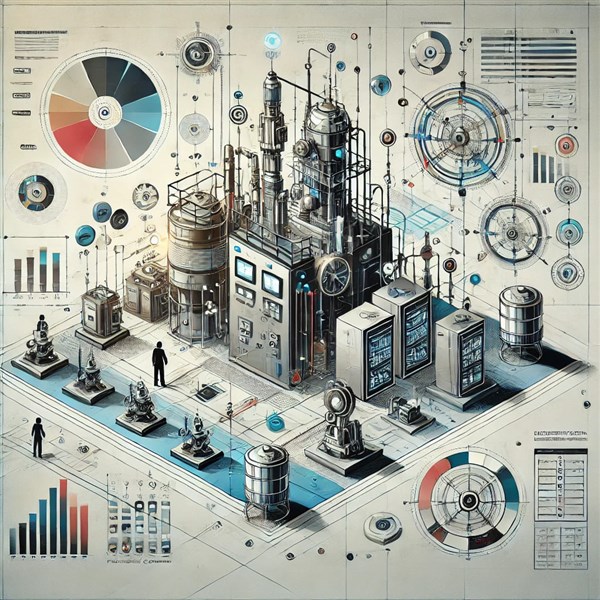We're open through the holidays to support your upskilling goals — book your session today!
We're open through the holidays to support your upskilling goals — book your session today!
Unable to find what you're searching for?
We're here to help you find it
In today’s world, industries rely heavily on automation and precise control of processes to maintain efficiency, safety, and quality. Whether it's manufacturing, oil & gas, pharmaceuticals, or food production, Instrumentation and Process Control play a critical role in ensuring smooth and accurate operations.
But what exactly is instrumentation and process control? And why is it so important?
This beginner’s guide will provide:
✔ An introduction to instrumentation and process control
✔ Key components involved in process automation
✔ How control systems enhance industrial efficiency
✔ Real-world applications in various industries
Let’s dive in!
Definition
Instrumentation refers to the science of measuring and controlling physical and chemical variables such as temperature, pressure, flow rate, level, and humidity. It involves using various sensors, transmitters, and controllers to gather data and adjust processes accordingly.
Key Elements of Instrumentation
✔ Sensors & Transducers – Convert physical measurements into electrical signals (e.g., temperature sensors, pressure transducers).
✔ Transmitters – Send data from sensors to controllers.
✔ Controllers – Process the data and make decisions (e.g., PID controllers, PLCs).
✔ Final Control Elements – Devices that adjust the process, such as valves and actuators.
💡 Example: In a power plant, instrumentation ensures that boilers maintain optimal temperature and pressure levels, preventing overheating or failure.
Definition
Process control is the technique of automatically managing industrial processes to maintain desired output and efficiency. It involves monitoring variables, making adjustments, and ensuring stability using control systems.
Types of Control Systems
✔ Open-Loop Control: A system that operates without feedback (e.g., a washing machine with a set timer).
✔ Closed-Loop Control: Uses feedback to adjust operations in real time (e.g., an air conditioning system that adjusts temperature automatically).
💡 Example: A water treatment plant uses closed-loop control to ensure pH levels stay within a safe range by automatically adding neutralizing agents.
✔ Temperature Sensors – Thermocouples, RTDs (Resistance Temperature Detectors)
✔ Pressure Sensors – Strain gauges, piezoelectric sensors
✔ Flow Meters – Magnetic, ultrasonic, and turbine flow meters
✔ Level Sensors – Ultrasonic, capacitive, and float-type sensors
💡 Example: A flow meter in a chemical plant ensures that the correct amount of liquid flows through pipelines to avoid waste.
✔ PID Controllers (Proportional-Integral-Derivative) – Adjust process variables based on deviations from setpoints.
✔ Programmable Logic Controllers (PLCs) – Industrial computers that automate processes.
✔ Distributed Control Systems (DCS) – Manage multiple processes across large-scale operations.
💡 Example: A PID controller in a bakery maintains oven temperature by adjusting heat output when temperatures fluctuate.
✔ Control Valves – Regulate fluid flow based on process needs.
✔ Actuators – Mechanisms that control the movement of valves or switches.
✔ Motors and Pumps – Adjust speed and pressure to optimize performance.
💡 Example: A motorized valve in an oil refinery controls fuel flow to maintain efficiency and safety.
✔ Requires human intervention.
✔ Used in small-scale operations.
💡 Example: A worker manually adjusting a gas valve based on pressure readings.
✔ Uses sensors and controllers to adjust processes automatically.
✔ Improves efficiency, accuracy, and consistency.
💡 Example: An automatic bottling plant uses sensors to detect bottle levels and control filling machines.
✔ Monitors and controls multiple processes remotely.
✔ Used in industries like power generation, oil & gas, and water treatment.
💡 Example: A SCADA system in an electricity grid detects faults and reroutes power to prevent outages.
✔ Controls complex, large-scale processes in real-time.
✔ Common in industries like petrochemicals and pharmaceuticals.
💡 Example: A DCS in a pharmaceutical plant controls drug mixing and packaging to ensure precision.
✔ Enhances Efficiency – Reduces waste and optimizes resource utilization.
✔ Improves Safety – Prevents equipment failure and hazardous conditions.
✔ Ensures Product Quality – Maintains consistency in manufacturing.
✔ Reduces Human Error – Automates processes for better accuracy.
✔ Meets Regulatory Compliance – Ensures industries follow safety and environmental laws.
💡 Example: In the food industry, temperature and pressure control ensure food safety and prevent contamination.
✔ Pressure, flow, and temperature sensors monitor pipelines.
✔ SCADA systems detect leaks and prevent accidents.
✔ Robotics and automation streamline assembly lines.
✔ PLCs control machine operations.
✔ Sensors measure pH, turbidity, and flow rate.
✔ Automated systems regulate chemical dosing.
✔ Temperature and humidity control ensures drug quality.
✔ Automated dosing systems improve precision.
✔ Turbine control systems optimize energy efficiency.
✔ SCADA ensures stable electricity distribution.
✔ IoT & Smart Sensors: Wireless sensors enable real-time data monitoring.
✔ AI & Machine Learning: Predictive maintenance prevents equipment failures.
✔ Cloud-Based SCADA: Allows remote process control and monitoring.
✔ Cybersecurity in Control Systems: Protects critical infrastructure from cyber threats.
💡 Example: AI-powered sensors in a factory predict equipment failures before they occur, reducing downtime.
Conclusion
Instrumentation and process control are essential for modern industries. From temperature regulation in manufacturing to real-time monitoring in power plants, these technologies enhance efficiency, ensure safety, and improve product quality.
🚀 Key Takeaways:
✔ Instrumentation involves sensors, transmitters, and control elements.
✔ Process control ensures stability and automation in industrial settings.
✔ Industries like oil & gas, food production, and pharmaceuticals rely heavily on these systems.
✔ Future trends include AI, IoT, and cloud-based automation.
Understanding Instrumentation and Process Control is crucial in our technology-driven world. It not only enhances efficiency and safety in various industries but also opens up a plethora of career opportunities. Thankfully, with training providers like Koenig Solutions, learning these skills has never been easier.
📢 Looking to build a career in instrumentation and process control? Consider enrolling in a professional certification program to gain expertise!

Aarav Goel has top education industry knowledge with 4 years of experience. Being a passionate blogger also does blogging on the technology niche.










